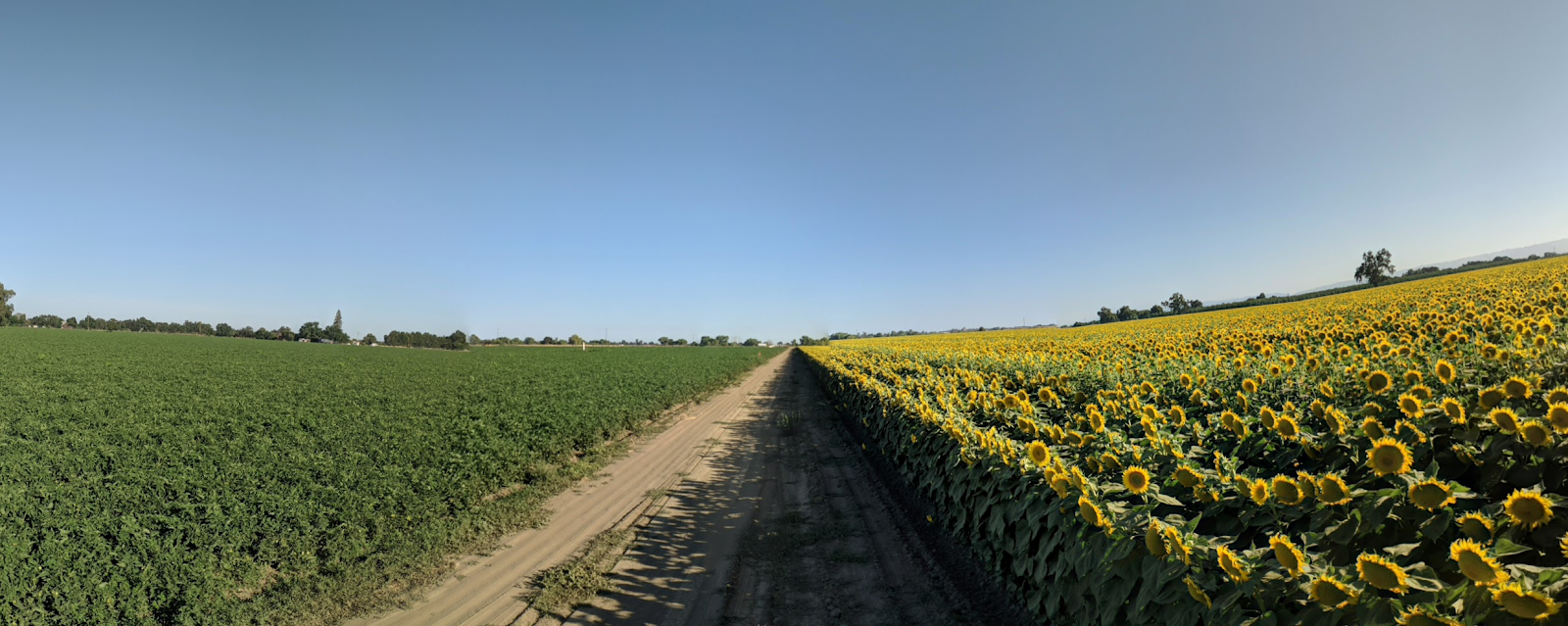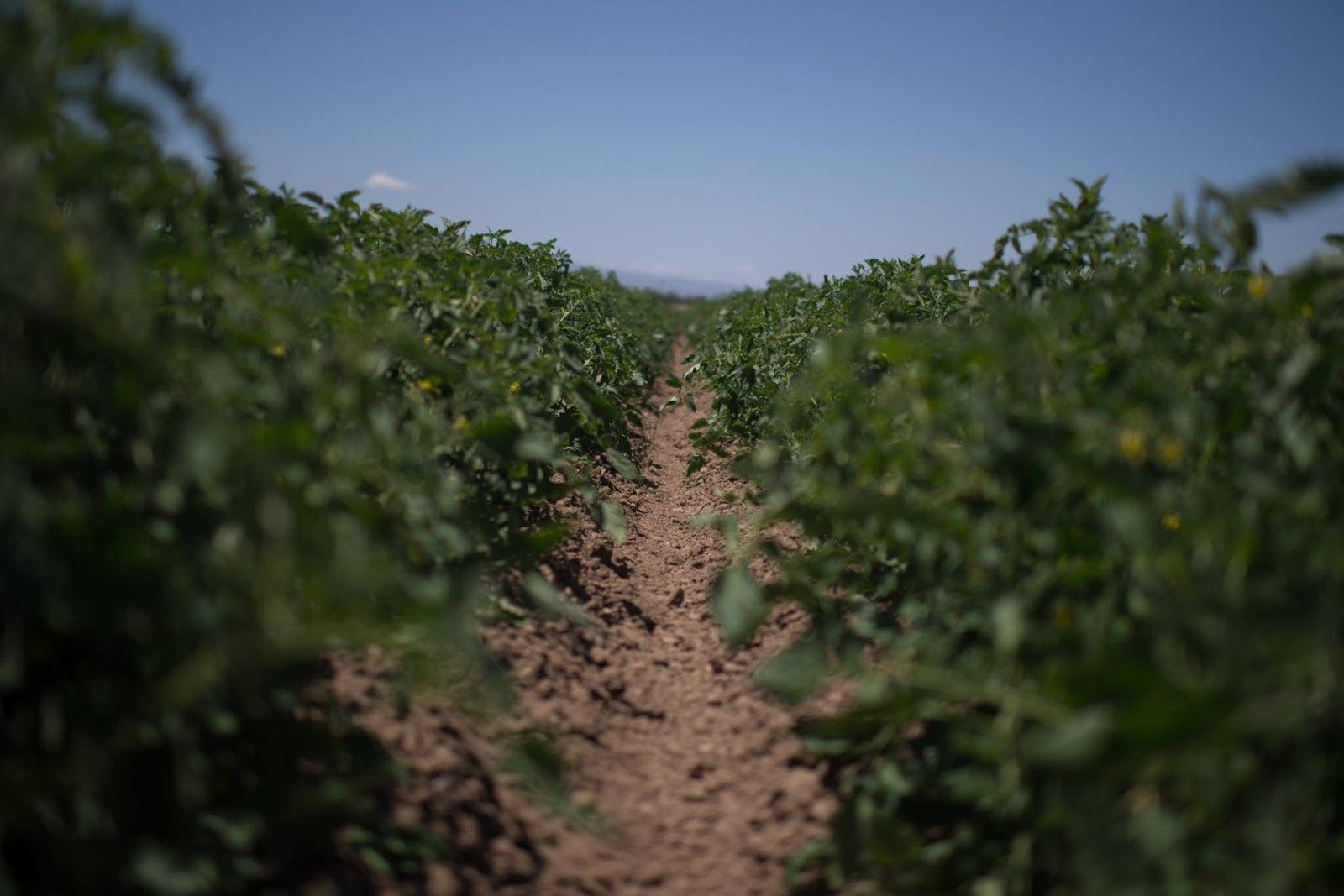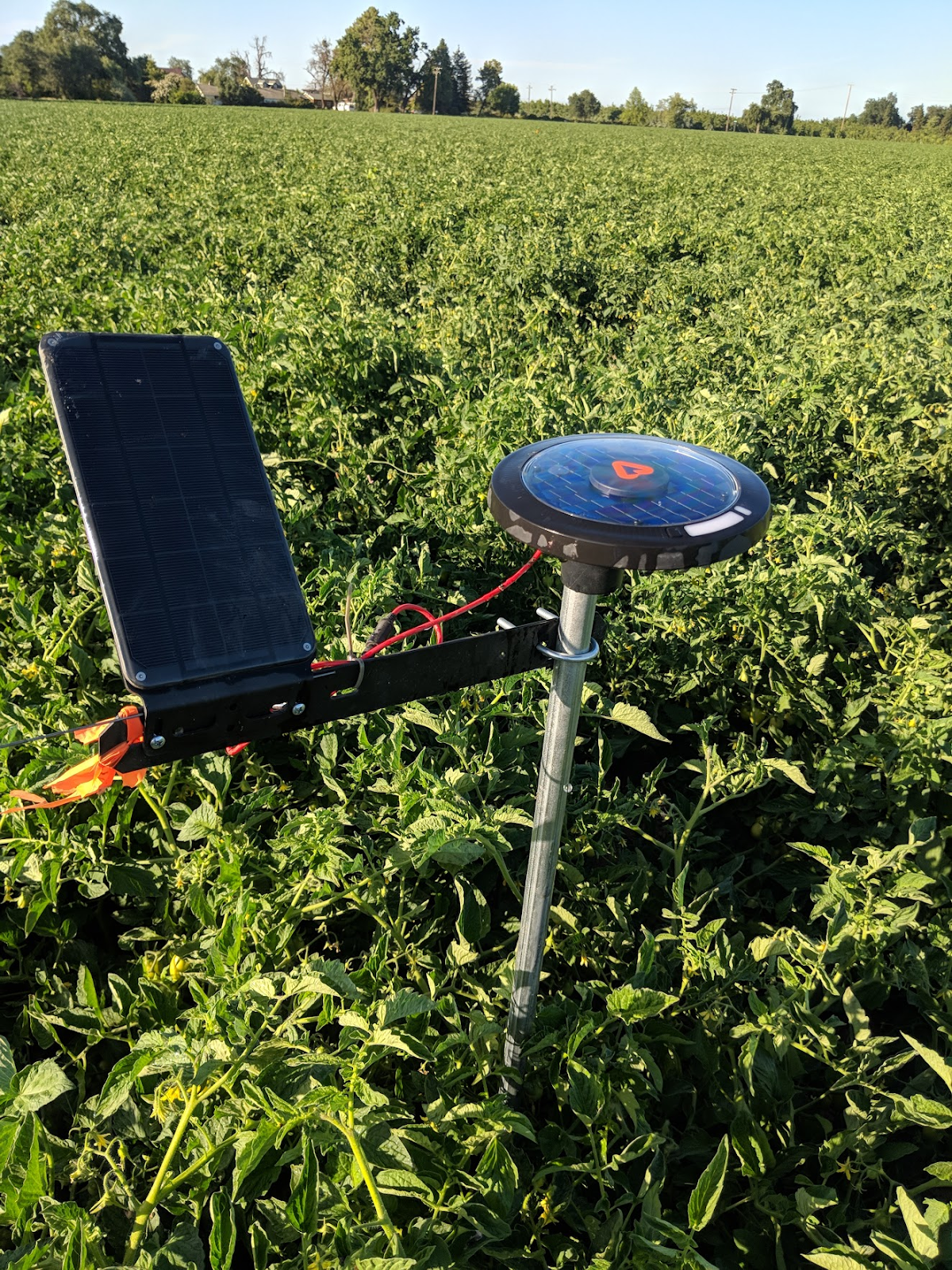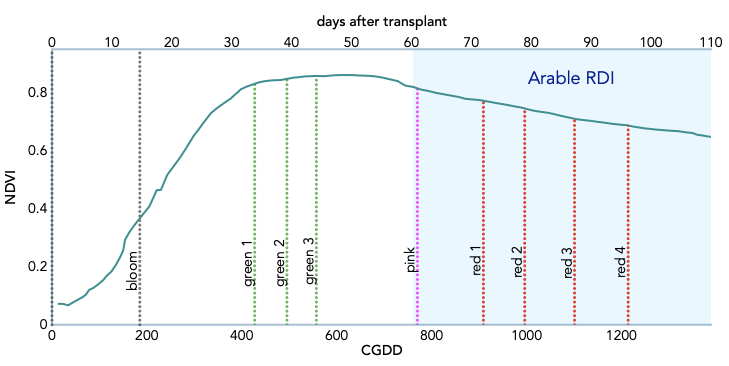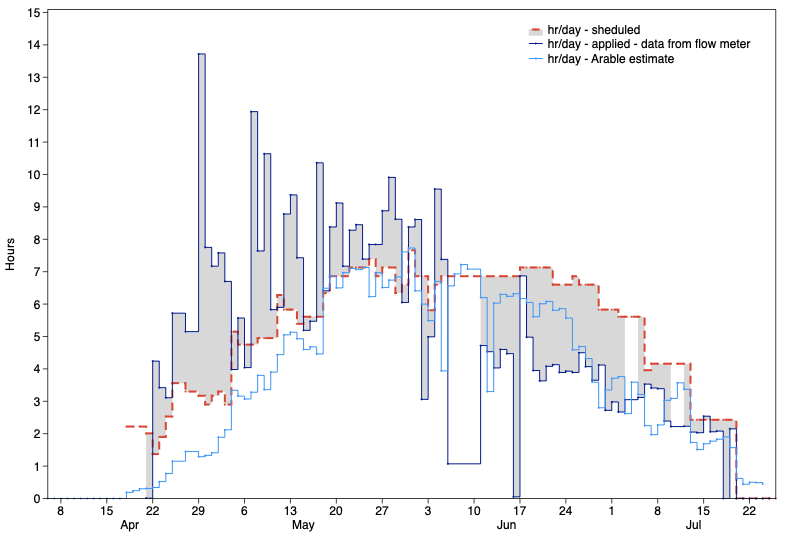With Tomatoes, Less Is More
How Muller Ranch Packs in More Flavor Using Less Water.
Tomatoes and sunflowers at Muller Ranch in Yolo County, California. Photo by Lorelí Carranza.
As you round the final bend of Road 95 through the groves of walnut and almond trees, it would be easy to miss Muller Ranch, but for the cluster of pickup trucks circling the driveway. Yet amidst these swaying Yolo County orchards sits a stunning third-generation, family-owned farm, thriving with several thousand acres of processing tomatoes, specialty peppers, corn, wheat, canola, cucumbers, grapes, garlic, and sunflowers. For the past two years, Arable has had the opportunity to spend a considerable amount of time learning from Frank Muller, his son Colin, and the other irrigation specialists on their staff about how to design and implement a specialized irrigation strategy that could shape the way crops are grown and watered. From February through August each year, we have the privilege of working in Frank’s prized 2400 acres of processing tomatoes to understand the effect of irrigation approaches on fruit yield and quality.
California’s processing tomatoes, like its wine grapes, are typically drip irrigated to allow for a precise application of water. Highly technical farmers like the Mullers will implement an irrigation strategy known as Regulated Deficit Irrigation (RDI) that optimally increases soluble solid content (also known as Brix) through the calculated manipulation of water application. At a specific time in the crop development cycle — such as the beginning of the pink fruit stage, around 55–70 days after transplant — maintaining a certain level of crop water deficit stresses the tomato plant in a controlled way, telling it to send carbohydrates — the stuff that makes tomato paste taste good — to develop its fruit rather than to grow more leaves and stalks. This drives up the fruit’s soluble solid content, thereby growing a more valuable product. It doesn’t just benefit the farmer, it also saves energy at the processing plant: a fruit with more soluble solids has inversely less water to boil out to make that delicious paste, cutting natural gas use significantly. If done correctly, RDI in processing tomatoes can lead to several significant production benefits:
– Reduced irrigation: saving water, time and money. Our field-level ETc data suggest a 15% reduction in water use, which is valuable in prolonged drought conditions.
– Higher soluble solids: reduced energy costs and GHG emissions at the processing plant and better price for the grower. Estimates show appx. $6M cost at plant.
– Increased soluble solids: better flavor.
– Reduced moisture in the fields: less disease pressure at the end of the season.
Processing tomato field at Muller Ranch. Photo by Jess Bollinger.
Frank is one of the most progressive farmers we’ve met, a pioneer in water conservation and sustainable management practices. He upgraded all his acreage to drip irrigation in the 1990s, utilizes deficit irrigation strategies, and is constantly seeking to improve the Mullers’ operation. When we first met to discuss the concept for the project, although his team had already implemented RDI, he told us how he thought they could probably water even less without sacrificing tomato yields, and increase their soluble solids, to gain a premium on quality. Despite frequent scouting to assess canopy development, he felt that the team was still struggling to pinpoint the right moment to implement RDI strategy, due to varying tomato genetics, planting dates, and field conditions. It’s not an easy task, since dialing back water too early can dramatically reduce yield, making it financially very risky to start RDI too early. To mitigate the risk, the team decided to wait until they could actually see water in the field before dialing back the irrigation, with the tradeoff being a loss of premium on quality. Arable and Muller Ranch collaborated with Dan Johnson, an irrigation engineer at USDA NRCS, to build out an RDI guide to address this issue. To inform our guide, we decided to collect the following information at the level of individual irrigation management zones:
Daily monitoring of phenological progress by variety and field to identify optimal timing to transition period from regular irrigation to an RDI strategy.
Measuring ETc by irrigation management zone to assess irrigation needs relative to evaporative demand.
Accurately measuring and forecasting field-level weather events to better evaluate potential future risks and scenarios.
Accurately measuring the amount of irrigation applied as a final check that the strategy has been successfully implemented.
At the start of the project, we sat down in Frank’s office, and he explained what a successful RDI system would look like:
“Ultimately, the technology that will rise to the top will be able to show, in real time on a site-specific basis, what has happened recently in the field, what is the current status, how many hours of water is applied on a daily basis, what is the projected ET-based need for the following day and week, and how many hours of irrigation should be put on today. It will be a decision-maker, and will communicate the conclusions it has reached based on the site-specific data it has gathered. Predictive capability is the key.”
Challenge accepted. Here’s how we did it:
-
We installed Arable Marks every 20 acres in a representative portion of the field to measure ETc by combining energy budget information from a four-way net radiometer (up, down, shortwave, and longwave radiation) with static properties of air (temperature, humidity, pressure), and a direct measurement of crop temperature.
-
Arable calculates heat units, or cumulative growing degree days (CGDD), by capturing air temperature every five minutes and recording daily maximum and minimum temperatures. The accumulation of CGDD is what primarily drives crop metabolic responses. We also measure other attributes of weather (relative humidity, pressure and precipitation), and build field-level weather forecasts to help us understand impending risks on a field-by-field basis.
-
Through a seven-band spectrometer (which captures wavelengths from the visible spectrum to the near infrared spectrum), the Mark then calculates a dailyNormalized Difference Vegetation Index (NDVI), which determines the density of green in a plant canopy. This index acts as a visual proxy for what is happening in the tomato fields; for example, as tomatoes enlarge and ripen, the NDVI values will lessen as the colors reflected will start looking less green and more pink, orange, yellow, red, or purple.
-
Using Arable’s ability to integrate other third-party sensors, we connected Badger Flow Meters to monitor water application through the drip tape, allowing us to verify the quantity of water applied in each field through a single platform.
An Arable Mark and auxiliary solar panel above the processing tomato field canopy at Muller Ranch. Photo by Lorelí Carranza.
Frank was right. Besides being able to get field-level ETc measurements and flow meter readings to precisely manage water application, in each field we could essentially “see” the transition between vegetative and flowering/fruiting stage. By using the combination of field-level measurement of heat accumulation (CGDD) along with the NDVI measurements, we were able to juxtapose the phenological development of the variety with environmental conditions and traditional crop models for processing tomatoes. Here’s an example:
With data from Muller Ranch processing tomatoes in the 2018 growing season, Arable’s irrigation calculation template shows combined CGDD & NDVI, indicating when to begin RDI.
We were excited to show the team at Muller that we had not only been able to get more accurate ETc measurements but that we could also determine the best time to transition to RDI using the spectral measurements. As we sat in the conference room going through the graphs and CSV files, Frank was brutally honest with us. He was impressed with the data and how it could be used to inform real-time operational decisions, but we missed a critical step: we needed to make all this data easy for him to use to make decisions! While it was one thing to design the system to collect all the variables and validate their accuracy, we were still missing a few key components that would make this data truly actionable for Frank and his team.
With 2400 acres of processing tomatoes alone, saying that the Muller team is busy is an understatement. Different varieties mature on varying time scales, and environmental conditions change hourly across their fields. We needed to organize this information to meet the needs of management, the irrigation foreman, and the field staff to facilitate the behavioral change that would achieve the desired outcomes. Frank’s feedback has led us to develop several key enhancements, including improved reports that get sent out on a daily basis, alerts that highlight key events as they occur, and a mobile app to put the critical information in the hands of the farm managers when they need it in the field.
Aggregate view of irrigation run times in hours per day at a site in the Muller Ranch field. The red dashed line represents the hours that the Muller team intended to irrigate at their fields, based on local forecasts. The solid purple line represents the hours that Arable Bridge was reading pulses through an attached flow meter, showing the actual hours that the irrigation was flowing. The blue line is hours Arable estimates they should have irrigated, using an in-field crop ET measurement. Gray shows the difference between what was applied and what they intended to apply, with gaps when they turned off the pump.
We are always looking for feedback and ideas to improve our platform, and to make field-level decisions easier for growers. This joint venture between Arable and Muller Ranch is the first scalable field-data study to assess the viability of using ET to predict results based on a grower’s desired outcome. To know how plants will cope under given conditions is to truly understand them, and builds a resilience that resonates beyond just the plants themselves, throughout the farm, region, and ultimately, the entire food chain. The Mullers have intimate familiarity with their plants, and deep knowledge of how they grow best. Arable is able to provide granular insight into key stages of plant development in a way that enables growers like Muller Ranch to act on this knowledge and realize their goals.
For more information on the Arable Platform, visit our web site.
